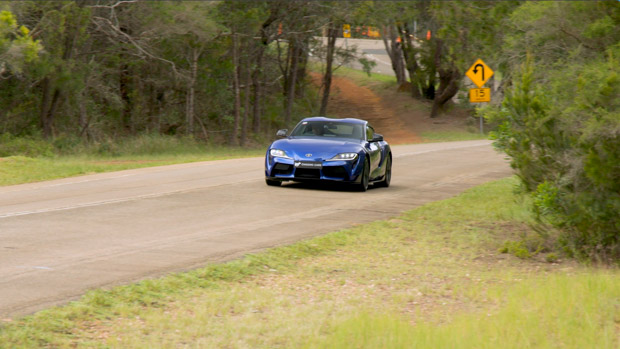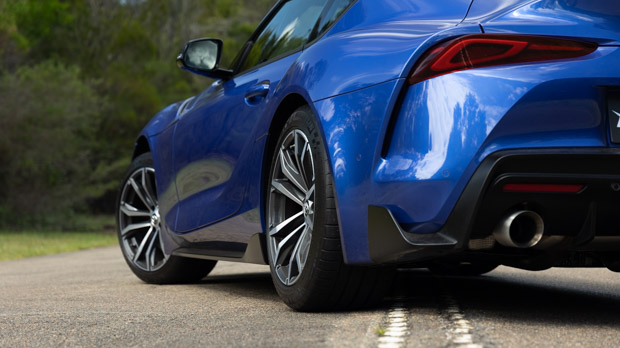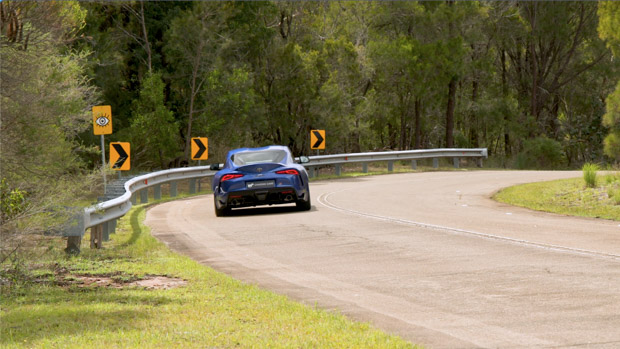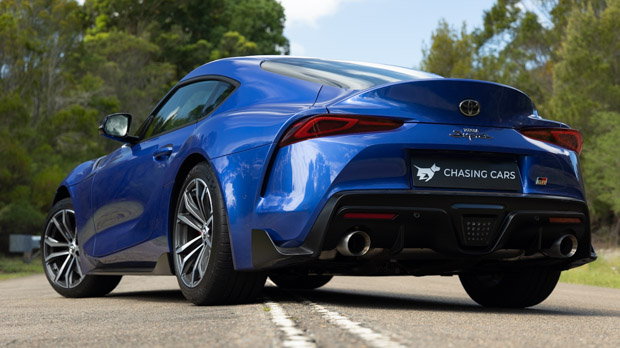-
Car Reviews
- Car News
-
Car Comparisons
Latest comparisons
- Chasing Deals
The manual option really is the icing on the fifth-gen Supra’s driver-focussed cake. And the buck-banging GT spec proves to be sweetest spot in range
Toyota has released a slower Supra. And it’s a better sportscar in spite of it. And because of it.
Back when the A90 arrived in 2019, returning a nameplate that enjoyed growing legend status throughout a 17-year hiatus, we and many other critics heaped praise on this 250kW, auto-only reboot.

“If Toyota can keep momentum rolling with even more powerful versions and alternative transmission choices, the A90 Supra will truly be the halo product Toyota wants it to be for its fun-to-drive future,” we wrote.
They have. And it is. Here we are, almost four futuristic years later, with power grown to 285kW and its wondrous turbocharged 3.0-litre inline six tied to a proper old-school manual gearbox.
At 4.4sec claimed for the 0-100km/h, it just one-tenth shy of the old 250kW auto – three-tenths off the newer, 285kW slush-boxer – but sheer pace apart the conventional cog-swapping versions are, in your author’s opinion, simply better in most respects.
That’s because the manual ’box feels like the final, conspicuous missing ingredient in Supra’s fun-to-punt driver engagement.

The first impression of the manual, that lobbed late in 2022, is: was Supra always this good? In short, not quite.
The power hike arrived in late 2020, along with extra bracing to enhance structural chassis stiffness. Two years on, the six-cog manual availability coincided with steering and suspension tweaks, if subtly so to polish up what was an already well-honed driver’s machine straight out of the oven.
The gearbox itself, a ZF unit, is closely related to those specified machines such as BMW M3 and Z4, though not the same.
Its closely stacked ratios put fifth at one-to-one – Z4’s if fourth gear – while the clutch is larger and heavier duty, the linkages revised, and the shifter mechanism upped in weight for an ideal shift feel.

The gearbox is six-cylinder Supra specific – a four-pot is sold overseas – and Toyota has added rev-matching for both up- and down-changes, that can be switched on and off. It’s also 18kg lighter than the auto, while net vehicle savings is around 40kg (says Toyota Europe).
Further downstream, the manual Supras fit a ‘short’ 3.46:1 final drive ratio – the auto gets 3.154:1 – in tandem with its electronically controlled, mechanical-locking rear LSD.
Other changes? The centre console and stack was massaged to allow clearance between your left-hand knuckles and the HVAC controls; and the traction and stability control protocols were revised to provide less or more slip than offered prior in different driving situations.
Less snap oversteer? More wheelspin in hairpins? Its maker claims that these sorts of augmentation have crept into Supra’s evolution with rolling changes.

The manual option is no more affordable than the (more complex) auto versions of the base GT and high-spec GTS, which might seem like a rub considering investment in hardware.
But the promised dividend in engagement and – perhaps – connected sportscar purity will seem a premium point of difference to some owners. If, that is, the Toyota halo car delivers on its promise authentically enough.
As mentioned, both manual and automatic choices demand identical outlay in Supra’s two variant tiers. In entry-level GT guise, it’s $87,000 before on roads. Meanwhile, it’s a ten-grand walk-up for the $97,000 GTS.
While postiioned as the base model, there’s nothing basic about the GT’s spec and features list.

Crucially, there is very little difference in performance credentials: 18-inch wheels rather than the GTS’s 19s – albeit with identical 255mm/275mm tyre-width stagger – and 330mm rear brake rotors rather than the flagship’s 345mm spec.

In contrast, the GTS adds $10K for a total outlay of $97,000 before on roads, adding the following features above the GT trim:
While the GTS targets completist buyers, the more affordable GT is the clear value leader of the range given its healthy standard equipment and acacdemic performance compromise.
Besides, the $10K saving over the GTS buys a lot of fuel and rear rubber for enthusiastic recreational shenanigans.
“Numbers are one thing (but) it’s the feeling that matters,” has been an official Toyota mantra, as relayed to Chasing Cars by A90 chief engineer Tetsuya Tata on one occasion. So let’s start with the ‘bad news’…
Dumped or walked off the line, default or optional Traction mode engaged, the Supra lunges off the line with degrees of wheelspin if solid drive and impressive thrust.

As the turbo six nudges the limiter in second gear around 105km/h-ish, it’s just one (mostly flat) shift to triple figures.
Result? At our own test track, yours truly managed a 4.61sec best in run two, with a couple of 4.7s as back-up. With the mercury touching 30deg on a less than clean surface, there are maybe a couple of tenth in the Supra’s pocket.
Toyota Australia claims a 4.4sec best for the Supra manual, while Toyota Europe quotes 4.6sec. Either way, performance wise, our Azure Blue GT manual examples proves to be right on the money.
The Supra is a big-six, serious high-perfromance sportcar and, as long demonstrated in auto guise, there’s a weight to its controls that imparts substance without being excessively heavy.

The steering, brake feel, even how it hunkers on the road means business…and the same goes for the calibration of the manual transmission and clutch.
Adding to that, the six-speed has a subby short throw and its gates are tight and mechanical, much more positive than what I remember of the rubbery BMW stuff hewn from the same ZF family.
The shifter is positioned a little reward of ergonomic perfection – by maybe three centimetres – though you quickly realise there’s just enough knuckle clearance forward to the HVAC stack and emply left elbow room for clean rearward shifts. The shifter is simply located where it had to be.
It’s a good pedal box: big left foot clearance and nice proud deadpedal for support, a flat clutch and brake pedal stagger, while the accelerator is counter just enough for handy heal-toe provided you’re deep enough on the anchors.
They’re centred ideally and, like the rest of the driver controls, everything lands perfectly to hand and foot.

The Supra’s moderately weighted driver engagement is your author’s favourite virtue. The Toyota isn’t MX-5-like snickety slick and light, nor is it as agricultural as a V8 Mustang.
Nothing is lightswitch urgent nor overly vague. And it’s the perfect duality for the Supra’s charactistic breath of hard-charging one minute, polite urban driving the next.
The clutch has a soft bite point quite low in the pedal throw and won’t be to all tastes. But your reviewer is a fan. It’s easy to modulate during hard launch but is so cooperative that it’ll walk off the line in traffic using second gear if you’re feeling lazy.
The clutch feel is matched wonderfully by the big inline six that’s surpemely traceable off idle, piles on 500Nm at just 1800rpm and pulls like a freight train to the 5800rpm redline and on to the 6500rpm limiter. It’s calibrated well for fluster-free daily driving.

Normal drive mode is good: a touch lazy in low-rpm if impressively flexible everywhere else. Engaging sport mode opens up the exhaust lungs a little and injects a roar and enthusiasm with its taps fully open that’s equally fiercesome and exhilarating.
Without the complexities of an auto transmission, it doesn’t want for a ‘sport plus’ mode at all. That said, even the eight-speed torque converter Supra sticks with two drive modes.
It’s simply quick (normal) and quicker (sport), becoming more lively and wicked depending on how much the driver want to invest in the experience – an experience that so often oozes with character without coming across as being tiresome or juvenile.
There’s a lovely dignity to the Supra’s manner, but if you do fell lairy, the aforementioned and independently switchable ‘traction mode’ relinquishes stability control as a matter of course.

Toyota has also managed to coerced a fat, tubular whoosh to the soundtrack that – to personal taste – is more preferable the lumpy and mechanical zing of BMW’s M-cars using closely related engines.
There’s also a taut solidity to the Supra that feels like Toyota at its best and undoubted owes to its BMW manufacture (in Austria, unlike any of its Japanese-built forebears).
The upchange/downchange rev-matching is particular useful around town, smoothing our the commute where it defaults to on in normal drive mode.
In sport, in the heat of battle, it’s most useful in the fourth-third-second downchanges when piling in a hairpin at warp eleven, though in this mode its switchable if you prefect the older-school tap-dancing challenge.

The chassis is fantastic. Supra is quite nimble for its 1.5-tonne heft and there’s a sense that track width, wheelbase and tyre size are tuned perfectly for dynamic driver interplay.
Dive into a corner hot and the chassis drills down on the available friction of those broad Michelins. Misjudge entry speed or trajectory and grip recovery is progressive and predictable.
The cooperation of the 50:50 fore-aft weight balance really comes into play once you’re shifting the body weight hard onto specific tyres as there’s a playfulness in the responses that suggest that you adjust trajectory or let the tail hang out and the Supra with remain obedient to the driver’s whims.
The liveliness is really evident when you a) lift off throttle mid-corner too eagerly or b) get too ham-footed on the throttle exiting tight corners, because the tail will respond with an enthusiasm that’ll grab your attention, of not to quite to point of getting overly ragged or unruly. Hot damn it’s a hoot!

But if you resist the urge to manhandle/womanhandle the situation and moderate your inputs, the Toyota can becomes wickedly quick point to point on a twisty road or track.
The Supra isn’t the quickest corner carver out there for reasonable money, nor a list-topper for the best bank robbery getaway car under $100,000.
But taming its nature to serve sheer pace would surely spoil its genuine sportcars character and the particular driver interaction it’s ultimately selling.
The auto Supra is good. But the manual format does something different, creating a more intimate union between the engine and driver’s right foot that, as a result, makes the Supra’s on-road and on-track experience that much more engaging. Even if it’s not necessarily the optimum choice for outright pace.

Ride? It’s firm (front axle) and firmer (rear axle), with a pliancy that’s quite pleasant around town provided you steer clear of potholes and sharp-edges.
We’ve remarked in the past the sport damping yields an overly pitchy ride, though it’s claimed the suspension has been tweaked since and, frankly, there’s little distinction between the two available settings.
The sport custom option allows users to adjust damping, steering and engine settings – as well as rev-matching deactivation – but, really, it’s as well-rounded as a fine modern sportscars ought to be without fiddling with finer settings.
And thus, for the duality of daily driving and fairweather punting, the Supra manual is an extremely fit and rewarding solution.
Entry and egress is a challenge. Climbing in, you have to watch banging your head on the low-slung roof sill.
Climbing out, the long doors make for narrow exitways parked parallel and you have to deadlift your body from the door jamb sill rather than the adjacent bodywork lest, like MX-5, you risk dislodging its sideskirt.

However, once you’re inside, the Supra cabin is as high in quality as Toyota gets by measure of material choice, tacility, solidity and general execution.
And it’s not simply the BMW switchgear, the BMW infotainment software/hardware bundle and its rotary control array, or necessarily its BMW manufacture.
Instead, the interior feels like a fine collaborative from two companies, with high expectation and care, with a symbiotic character that doesn’t ape either company’s models and is more convincing in execution than many of them wearing either German or Japanese badges.
So while it’s rungs above Corolla and RAV4, it’s also richer and nicer than many cut-priced Bimmers, too.

It’s snug, both spatially and, in particular, those rib-hugging bucket seats. You seem to sink below the windowline and the slim glasshouse does exacerbate the sportscar vibe.
But it is comfy, at least ergonomically, and the seats offer an array of electric adjustment to relieve some of the torso-gripping enthusiasm.
The semi-digital driver’s screen, with its central tacho roundel is charmingly old school and a damn sight clearer and nicer than BMW’s awful hexagonal-themed digital eyesores.
How the needle swings from due south for idle to due north for redline is a neat and intuitive design format.

The Supra’s petite 8.8-inch touchscreen bucks more-is-more trends, though it’s refreshingly minimal and befitting the sportscar vibe.
Bar the Supra-themed landing page, the multimedia interface and content is oh-so-BMW, right down to the rotary console controller and shortcut buttons.
Features wise, it’s a mixed bag. The satnav is okay and the 10-speaker GT-spec audio is surprisingly good, though the tiny, fisheyed reversing camera isn’t quite as helpful as it should be.
More beneficial, though, are the front, rear and helpful ‘clearance’ sensor array to help prevent you beaching Supra’s low-slung bodywork on the landscape.

Downsides? With your left elbow in motion during gearchanges, the console’s cupholders are useless for anything bar small disposable coffee cups, though there’s elastic bottle and oddment holder on the passenger-side transmission tunnel.
Otherwise storage is near nonexistent. Also, the lower steering column cover comes very close to knocking your left knee cap while you’re clutch pumping.
Beyond the aluminium reinforcement bar behind the seats, the 290-litre bootspace is surprisingly handy.

You can remove the hard parcel shelf to liberate its fullest dimensions, which also amplifies the the exhaust note’s throughout the cabin with a bit of extra bottom end resonance, if that’s your sort of thing.
Fit for purpose? Absolutely. But practical? Not really. Such is the nature of the beast.
The A90 Supra has not been tested by ANCAP or Euro NCAP and is thus unrated.
However, the Supra does offers an array of safety equipment that includes:
During Chasing Cars’ independent testing, the Supra GT manual recorded a very respectable 100-0km/h emergency braking distance of 37.32 metres.
The Supra comes with five-year, unlimited-kilometre warranty, with seven years of engine and driveline coverage.
Servicing is required every 12 months or 15,000kms, whichever comes first, with a capped price of $415 per visit, or $2075 in total over five years.

That’s a very reasonable outlay for a high-performance sportscar and, thanks to its normalised service intervals, cheaper to service on average than the GR Corolla ($600 per year or $1800 for three years).
For comparison, the Nissan Z has 10,000km/12 month intervals with capped price servicing for up to six years, with a total cost of $3190 during that time in manual guise.
Unsurprisingly, the turbocharged inline six comes with a minimum fuel recommendation of 95RON premium.
However, the official specification datasheet states that regular 91RON is safety “usable” at a pinch, though it’s reasonable to expect less than optimum performance and efficiency whilst doing so.

Claimed combined fuel consumption is 8.9L/100kms. On test, commuting around Sydney with a fair component of peak-hour driving, the Supra GT manual sat around the ten-litre mark while regularly dipped down into the low nines.
During track assessment and performance testing, the thirstiest it got was in the 12s. Pretty impressive stuff.
Disclosure time: despite the widespread critical acclaim for the A90 Supra, I’m a latecomer to the fan-wagon.
Why? Firstly, I sit on the less than complimentary side of fence when it comes to the new-gen Supra’s polarising style, despite acknowledging that, yes, its form is a logical modern reimagining of the iconic A80 – itself no oil painting, at least unmodified.
And, secondly, I long thought it deserved and conventional cog-swapper, even though the eight-speed auto ‘works’ really well indeed. Purely for soul rather than, well, performance.

When the manual arrived, I just wanted Supra vibe to feel right. I’d hoped that it’s addition would be a glove fit. And I’d wished that it would augment its character closer to personal tastes.
Frankly, the Supra manual nails it. And despite reservations about how well those 18s fill Supra’s bolbous guards, the more-reatively-attainable GT is the no-brainer pick of the litter for value.
The Supra GT manual is one of two cars that have floated my personal boat much higher than most in the past 12 month. The other is Nissan Z.
Both are cut from similar cloth, in that they’re both thoroughbred sportcars how such a breed should be: turbo-six power, rear-drive, manual-equipped, somewhat old-school and keenly attuned to driver engagement. Pass those rose-tinged glasses, please!
There are a slew of fun cars that do certain things better. One is lightswitch pace delivery: if that’s your foil, buy an Audi RS3 and call it day. Ditto for practicality.

Your MX-5s and GR86s are leaner, your GR Yarises more accessible, your Mustang GTs more muscular and thunderous. But none of viable and appealing alternatives are proper, thoroughbred sportscars like the Supra.
In fact, the Supra GT manual is no quicker than a contemporary small electric SUV – the Volvo C40 Recharge Twin Motor, for example, is 4.52sec swift – is a sobering one. And the latter format is certainly a bandwagon many of the world’s carmakers are jumping onto.
Perhaps it might be wise not to sleep to long a traditional, turbocharged, manual rear-drive sportscar such as Supra GT manual if your eyewear is as rose-tinged as mine.
Key specs (as tested)
About Chasing cars
Chasing Cars reviews are 100% independent.
Because we are powered by Budget Direct Insurance, we don’t receive advertising or sales revenue from car manufacturers.
We’re truly independent – giving you Australia’s best car reviews.
The estimate provided does not take into account your personal circumstances but is intended to give a general indication of the cost of insurance, in order to obtain a complete quote, please visit www.budgetdirect.com.au. Estimate includes 15%^ online discount.
^Conditions Apply
Budget Direct Insurance arranged by Auto & General Services Pty Ltd ACN 003 617 909(AGS) AFSL 241 411, for and on behalf of the insurer, Auto & General Insurance Company Limited(ABN 42 111 586 353, AFSL 285 571).Because we don’t know your financial needs, we can’t advise you if this insurance will suit you. You should consider your needs and the Product Disclosure Statement before making a decision to buy insurance. Terms and conditions apply.
Indicative quote based on assumptions including postcode , 40 year old male with no offences, licence suspensions or claims in the last 5 years, a NCD Rating 1 and no younger drivers listed. White car, driven up to 10,000kms a year, unfinanced, with no modifications, factory options and/or non-standard accessories, private use only and garaged at night.
^Online Discounts Terms & Conditions
1. Discounts apply to the premium paid for a new Budget Direct Gold Comprehensive Car Insurance, Third Party Property Only or Third Party Property, Fire & Theft Insurance policy initiated online on or after 29 March 2017. Discounts do not apply to optional Roadside Assistance.
2. Discounts do not apply to any renewal offer of insurance.
3. Discounts only apply to the insurance portion of the premium. Discounts are applied before government charges, taxes, levies and fees, including instalment processing fees (as applicable). The full extent of discounts may therefore be impacted.
4. We reserve the right to change the offer without notice.